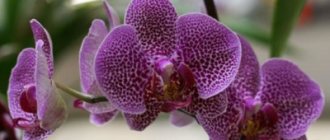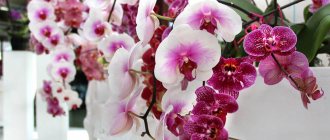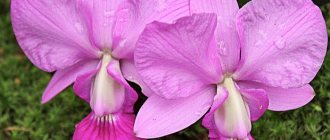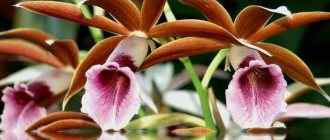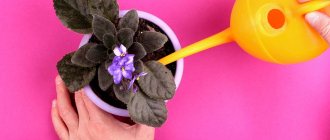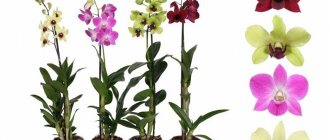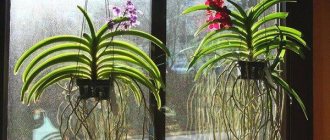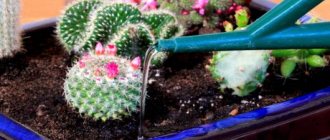The genus of orchids is very extensive and is represented by a wide variety of species. The flowering period for each of them is different, on average it lasts from two weeks to six months. Depending on the variety, the orchid can bloom 2 or 3 times a year. This feature depends on the genetic species of the plant. Of course, an orchid is beautiful at the moment of flowering. In order for her to please her owner again with delightful flowers, it is necessary to provide her with competent and qualified care. This is easy to do yourself at home.
Features of flowering
Volumetric inflorescences are located at the base of the peduncle. The shades of flowers and their shapes are incredibly varied. Colors can be monochromatic, interspersed, with original, unique designs.
The buds open gradually: the first are the lateral ones, then the upper ones, and then the lip opens. The process of full disclosure takes about 24 hours.
Attention! Before the flowering phase begins, you should take care of supports for the peduncle, otherwise it may break under the weight of the flowers. Exotic blooms at any time of the year.
How long does the period last?
It all depends on the variety and growing conditions. An orchid may well bloom several times a year, and recover during the breaks. Exotic blooms at any time of the year, usually up to 3 times in 24 months. If the period is much shorter, it means that something is bothering the plant.
For example,
- the common phalaenopsis can bloom for several years in a row almost without interruption;
- cymbidium - from October to February, and then, when it has bloomed, it may bloom in the summer;
- The flowering time of dendrobium falls in October and lasts until January.
Possible problems
Sometimes, when examining an orchid after flowering, problems may be discovered:
root diseases;- presence of pests;
- damage to the neck or leaves by fungal diseases.
If you find any of the above, urgently take measures to save the phalaenopsis. And be sure to isolate the sick orchid so that other flowers do not become infected. Sometimes problems are associated with improper care after flowering:
- Incorrect trimming.
- Violation of the fertilizer application schedule.
- Incorrect lighting.
- Inappropriate temperature conditions.
All these need to be diagnosed and eliminated in time, otherwise the plant will die.
What does the deadline depend on?
The quality and frequency of inflorescence formation is influenced by a number of factors.
- Moving the plant. Orchids do not like to be moved or rearranged. At the same time, they experience a kind of stress. Also for exotics, the position relative to the sun is important; even when watering, it is better not to mix the pot. Otherwise, the orchid may react by shedding buds, leaves, and yellowing of the peduncle (what to do if the orchid does not bloom at all?).
- There is not enough sunlight. Incorrect placement of the pot plays a direct role. Flowers prefer bright, but not scorching, light, as well as daylight hours of 14 hours. During unfavorable periods or the autumn-winter period, the plant requires additional lighting. Without light, the tip of the orchid begins to dry out, and its overall development slows down. For these purposes, phyto lamps are used, which shine intensely but do not dry out the air.
- Low air humidity. High air temperature and low humidity are dangerous parameters for plant life. The moisture evaporates quickly enough through the leaves, but the roots do not have time to nourish in time. A process of withering occurs, followed by drying out of foliage, flowers, and root systems. The maximum humidity level is 30-40%.
- Illiterate selection of nutrients. I would like to note that for the growth and lush green color of leaves, fertilizers with a high nitrogen content are used. On the contrary, for bright and lush flowering, mineral preparations based on potassium and phosphorus should be used. Just be careful when fertilizing; you can’t pour nutrient solutions directly onto the roots, as such actions can cause burns to the root system. Before applying mineral components, the soil should be slightly moistened.
- A sharp change in temperature and humidity conditions , the flower being in a draft. Daily ventilation has a positive effect on the condition of the orchid. But ventilation and draft are two different things. A draft is dangerous even for people, not to mention plants. Cold air flow can cause limp flowers. It is not recommended to ventilate if the plant has just been watered or sprayed.
- Condition of the root system. Roots are an important organ in the life cycle of orchids. They take part in the process of photosynthesis. To do this, they also need sunlight, so it is better to plant the plant in transparent plastic containers.
- Watering with cold water. This factor can negatively affect the condition of the root system. Cold water supercools the roots, which is fraught with the development of rotting processes, as well as the sudden fall of buds.
- Incorrect watering. A lack of fluid can occur in the complete absence of watering.
Important! The plant vitally needs a minimum volume of water, which dissolves the minerals in the soil and nourishes the root system. If there is insufficient moisture, the flowers wither and fall off, and the same thing happens with the peduncle.
What to do if orchids don't bloom?
There are several tricks on how to make orchids bloom.
Attention! You can only use one of the methods to stimulate flowering, since the simultaneous use of several measures will cause great stress to the plant. Physiological methods of stimulating flowering should also not be combined with chemical biostimulants.
This may lead to undesirable consequences.
Sometimes an orchid does not want to bloom due to too “ideal” conditions, then it should be created with a little stress.
Drought simulation
Orchid is a plant native to the tropics, where there is no division into the seasons of winter and summer. But there are periods accompanied by tropical rains, which are replaced by drought. This natural cyclicity can be used when keeping the plant indoors to solve several problems associated with the lack of flowering.
So, how to help an orchid bloom:
- monotonous watering of the plant has a positive effect on leaf growth, so climate change can trigger flowering;
- if nitrogen predominated in the diet of phalaenopsis, then the dry season will help get rid of it and stimulate the formation of flower buds;
- creating a lack of moisture, you must ensure that the room temperature does not rise above 30℃;
- the interval between waterings is almost doubled, during which time the roots should dry completely. In this state, in a warm room, the plant should stand for an additional 4-5 days and up to 7 days if the room is cool;
- at this time the orchid is not sprayed or fed;
- at the first appearance of a flowering arrow, plant care is resumed, excluding fertilizing;
- in winter, the orchid needs additional lighting.
This method can only be used for a healthy orchid; a weakened plant may die.
Warm shower
This technique is recommended to stimulate growth, flowering, and hardening of an orchid:
- cover the flowerpot with polyethylene to prevent water from getting in;
- before the procedure, phalaenopsis is watered with water at room temperature;
- the water temperature of a warm shower should be about 40-50℃;
- duration of plant treatment – 15-20 seconds;
- repeat the procedure every 10-12 days, with the exception of the winter period;
- After this, the orchid is left in a closed bath so that the plant cools completely.
Treating a plant with a too hot shower can cause undesirable consequences, so this procedure must be carried out with caution.
You can stimulate flowering with a warm shower.
Simulation of the rainy season
One way to wake up an orchid is to imitate an artificial rainy season. When carrying out water procedures, use only warm water heated to 35℃:
- water the plant for 3-4 days in a row (you can do it in the shower);
- then, within two weeks, watering is completely stopped to allow the roots to dry out.
After this time, watering is resumed and carried out as usual.
Important! All of these methods of stimulating flowering should be carried out against the background of reducing the amount of nitrogen in fertilizing and increasing the content of potassium and phosphorus. The optimal ratio of nitrogen, potassium and phosphorus to stimulate flowering is 2:6:6.
Use of chemicals
The use of biostimulants for daily spraying of leaves and weekly watering of the orchid adds energy to the plant and stimulates the shoot.
succinic acid
This drug activates many biological processes in the plant:
- strengthens the immune system;
- improves growth and development;
- stimulates the beginning of flowering and its duration.
The leaves are sprayed with a solution of succinic acid and the roots are soaked. After regular treatment, phalaenopsis forms new flower stalks, roots and leaves grow.
Succinic acid must be used according to the instructions.
Cytokinin paste
This is a hormonal drug containing a natural phytohormone - cytokinin. It is most often used in floriculture practice:
- stimulates cell reproduction;
- promotes awakening of dormant kidneys;
- stimulates plant growth;
- influences the formation of peduncles and prolongs flowering.
Its use helps restore weak plants and stimulates the formation of orchid babies.
Stimulation of children using cytokinin paste.
How often can the process be repeated?
How long does it take for orchids to start blooming again after the last bloom? The frequency of the process depends on its duration.
- If this period lasts 2-3 months, then the plant can bloom 3-4 times a year.
- If the flowering period is 5-8 months in a row, then in 12 months the orchid can produce flowers 1-2 times.
On average, the annual cycle reaches three times.
Representatives of the Orchid family live up to 100 years in the wild. There are specimens of 130 species that are 50 years old, and the life cycle of 500 species is about 20 years old. At home, the maximum life expectancy is 10 years, and the average is 5 years. This means that an orchid can bloom 15 times in its life, but this is an average. Everything is individual, and depends on the variety, conditions, maintenance parameters and genetic predisposition.
When does flowering occur for the first time?
The peduncle grows and forms exclusively in adult, healthy individuals before flowering. Their age ranges from 1.5 to 3 years. Another important parameter is the presence of a certain number of leaves. For full flowering, exotic must have 5-6 large leaves. At an earlier age, flowering is dangerous, because the flower is not yet fully ripe, and most likely it is in danger of death.
Reference. On average, an adult specimen blooms for about 3 months in a row, and a young one – 1 month. When the latter blooms after the first time, at least six months usually pass.
Option 1 – the peduncle has dried up
In this case, the dead part of the stem is removed by pruning. But only when the peduncle has really dried up. The most common mistake that novice gardeners make is cutting the stem immediately after the flowers fall. This cannot be done, since it still contains many nutrients that the plant actively uses for its vital functions.
The structure of an orchid stem is a hollow tube. With further watering, if water gets inside, the trunk and root system will begin to rot. Therefore, it is better to close (seal) the cut of the orchid peduncle. The most common method is beeswax.
Where to trim?
Approximately 1.5 - 2 cm above the so-called “sleeping point”. This is a conditional boundary between the dead part of the stem and the living one. But even here it is necessary to observe the recommended limit - the stump should not be lower than 2 cm.
Is it possible to extend?
Regulating the process of formation and appearance of buds is not an easy task. Much depends on how to care for the plant when it blooms. There are basic care rules that should be followed to achieve the desired result. The main parameters are daylight hours and air temperature. Changing these factors accordingly makes it possible to stimulate flowering, the formation of buds, and then stop or accelerate the blooming of flowers. A long flowering stage can be achieved with diligent and careful monitoring.
- Adding daylight is the first sign to prepare for the start of flowering. A sudden lack of lighting will immediately affect the condition of the orchid and the development of buds. A minimum of 12 hours of daylight is required, only in this case long flowering is possible. During the cold season, it is recommended to use artificial lighting. The quality of lighting also matters. Orchids prefer partial shade, diffused light. Bright, scorching rays can only do harm and speed up flowering.
- At the usual night air temperature of +18°C, flowers bloom faster, and to prolong this process, the temperature should be lowered to +15°C; this will also extend the flowering period.
For a correct, full-fledged flowering process, another factor is important - the temperature difference, which should be 4°C. Important! Hot air is unacceptable; the orchid should be in a cool place.
Secondary factors must also be taken into account:
- good ventilation in the room;
- watering with high-quality, warm water;
- fertilizing with potassium fertilizers once a week;
- moisturize every week;
- exclude transplants and spraying.
Thus, taken together, the fundamental factors make it possible to provoke the formation of buds, prolong current flowering as much as possible and prolong future flowering. However, all this is possible only with the great desire and diligence of the orchid owner. Love your plants and they will certainly love you back.
